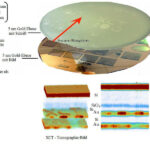- Home
- Technology Groups
- Competence Center for Micro- and Nanotechnologies
- Research results
- Micro and Nanofabricated Targets for High-energy Physical Experiments
Micro and Nanofabricated Targets for High-energy Physical Experiments

12.04.2018
IPHT works globally with scientists on new physical methods and develops test objects tailored specifically to particular experiments (e.g., multilayered targets for verifying the nanoscale axial resolution of novel optical coherence tomography or self-supporting silicon slit apertures for cryogenic hydrogen jets as a laser-driven source of proton beams) carried out in large accelerator research facilities.
By: Uwe Hübnrt // Silvio Fuchs // Sebastian Göde
The micro and nanostructuring workgroup at IPHT cooperates with scientists around the world on the research of novel physical methods and measuring techniques and develops special test objects (targets) tailored to the respective experiments. This article describes two current examples. The first one is multilayered silicon targets with nanometer-thin, covertly-embedded gold structures for verifying the nanoscale axial resolution in three-dimensional optical coherence tomography, in which beam generation is based on a laser-driven high-harmonic source (XCT at the IOQ at FSU Jena). In addition, self-supporting silicon slit apertures with sub-µm dimensions, which were manufactured using MEMS technologies, were produced in experiments for the generation and detection of efficient laser-driven proton acceleration from cylindrical and planar cryogenic hydrogen jets. These experiments were carried out at large accelerator facilities (Draco – Dresden laser acceleration source at the Helmholtz Center Dresden-Rossendorf, SLAC – Stanford Linear Accelerator Center in California/USA, and EuXFEL – European X-ray Free Electron Laser Facility in Hamburg).
- a) Targets for optical coherence tomography at extreme ultraviolet radiation
Extreme ultraviolet microscopy (XUV) is technologically challenging and has so far been largely limited to synchrotron radiation from particle accelerators and access to such large-scale equipment. Motivated by the high resolution and exceptional material contrast of this microscopy method, the IOQ at FSU Jena develops table-size device alternatives for laboratory use. A Ti:Sapphire laser system is used as a source for the generation of higher-harmonic radiation. The experimental setup and the results of the non-invasive 3D cross-sectional imaging of this XUV coherence tomography (XCT) are described in detail in [1]. For demonstrational purposes and to determine the lateral and axial resolution of this method, a special multilayer thin-film test object featuring nanometer-thin gold structures in the shape of images and letters in hidden layers was developed at IPHT using microlithographic methods. The starting point was a silicon wafer (diameter: 100 mm, thickness: 500 µm) onto which 5 nm thin gold patterns, separated by a 100 nm sputtered silicon layer, were repeatedly deposited, lifted, and finally buried under a 200 nm thick silicon layer. The gold layer closer to the wafer shows a large image, the higher gold layer shows smaller “XCT” lettering in different sizes (see Figure _01). The 3D images generated show structures with a very good material contrast, and the position of the buried layers was reconstructed with a depth resolution of 24 nm. Furthermore, it was possible to detect a native oxide layer measuring only a few nanometers in the 200 nm silicon cover, which was caused by a vacuum interruption during the Si coating process.
- b) Generation of efficient laser-driven proton acceleration from cylindrical and planar cryogenic hydrogen jets
In [2] we reported on the latest experimental results using a continuous cryogenic hydrogen stream as a renewable, laser-controlled source of pure proton beams generated with the 150 TW ultrashort pulse laser Draco (Dresden laser acceleration source at the Helmholtz Center Dresden-Rossendorf). Efficient proton accelerations, which achieve cut-off energies of up to 20 MeV, with particle counts of more than 109 particles per MeV per steradian, have shown for the first time that the acceleration performance is comparable to film targets with a thickness in the micrometer range. The technology for the generation of cryogenic hydrogen jets was developed at SLAC and the European XFEL. Two different target geometries were tested and their proton beam emission characterized: cylindrical holes (∅ 5 μm) and planar slits (20 μm × 2 μm). In both cases, typical target normal sheath acceleration emission patterns with exponential proton energy spectra were detected. Compared to the cylindrical circular aperture geometry, significantly higher proton numbers in the forward laser direction were observed in the planar jet. This is confirmed by two-dimensional particle-in-cell (2D3V PIC) simulations. These simulations show that a planar jet geometry leads to optimal acceleration conditions (in the investigated laser regime) [2].
The planar slit apertures were produced at IPHT using a combination of electron beam lithography and MEMS technology. The starting point was a silicon-on-insulator (SOI) wafer with a 2 µm thick silicon layer as “device layer”. Precise slit structures with widths ranging from 500 nm to 10 µm and lengths up to 20 µm were etched into the device layer by means of microlithography and plasma etching. In order to obtain self-supporting apertures (see Figure _02), the silicon and silicon oxide were subsequently removed wet-chemically at the back. At an aperture size of 3 mm x 3 mm and an arrangement on a 4” wafer (100 mm), more than 500 slit apertures are available for experiments in large-scale accelerator facilities.
Funded by: DFG, BMBF, HGF


